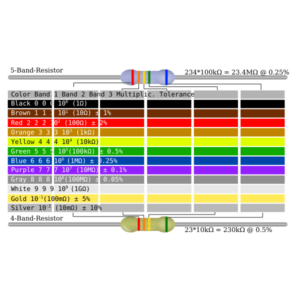Table of Contents
Introduction:
In the year 1920, a resistor colour coding was introduced. The body of micro resistor components has these colour bands printed on it. We can use the resistor mnemonic BB ROY Great Britain Very Good Wife for colour codes, where the first letter denotes a certain colour. Color-coding is used to identify the value and function of all electrical components and lines. Because we only utilize the below colours as tolerance coding on five bands, the five-band resistors are referred to as coloured tolerance bands:
- Violet • Red • Brown • Green • Blue
A resistor contains several different colour bands, each with its own purpose and function.
A brief outline:
There are four types of resistors based on the number of bands:
Three band resistors,
The multiplier is represented as the third band in a three-band resistor. A high-resistance multiplier is used to convert a galvanometer to a voltmeter. It also moves the decimal point around to alter the value from megaohms to milliohms and back. AB * C ± 20% is an expression that can be used to represent it.
Resistors with four bands
It is the most extensively used and common resistor. The first and second bands, like the three-band resistor, indicate the first and second digits of the resistance value. The third band stands for ‘multiplier,’ while the fourth band stands for tolerance. If indeed the tolerance band is left empty, the four-band resistor can become a three-band resistor. The resistance would be the same in this instance, but the tolerance will be ± 20%. The term AB * C ± D% can be used to indicate it.
Resistor with five bands
A third significant digit is added to the five band resistors. The first three bars represent the resistance’s respective digits. The multiplier is in the fourth band, while tolerance is in the fifth. ABC * D ± E% is a phrase that can be used to indicate it.
Resistor with six bands:
A six-band resistor is a five-band resistor with a temperature coefficient ring added. ‘Brown’ usually refers to the sixth band (100 ppm/K). In other words, the resistance value changes by 0.1 percent for every 10ͦ C change in temperature. ABC * D ± E%, F is a phrase that can be used to represent it. The sixth band is ‘F’ in this case.
Resistors comes in a range of shapes.
The following are the two types of resistors available:
- Resistors that are linear
- Nonlinear resistors
- Linear resistors are resistors whose value changes as the applied temperature and voltage change. Fixed resistors & variable resistors are the two types of linear resistors. Let’s examine at each one separately:
Resistors that are fixed
A fixed resistor has a fixed particular value, which implies that no matter what conditions it is exposed to, its value will not vary. The below are the different types of fixed resistors:
- Resistors with a carbon content
- Wire wound resistors
- Resistors with a thick film
The following are examples of thick film resistors:
- Fusible resistors
- Resistor films made of cermet
- Resistors made of metal oxide
The following are examples of thin-film resistors:
- Resistors made of carbon film
- Metal film resistors
Variable Resistors:
A dial, knob, or screw can be used to change the value of a variable resistor. Their uses in radio collecting stations for volume and tone adjustment are common. The following are the several types of variable resistors:
- Potentiometer
- Rheostat
- Trimmer resistors
- Resistors whose resistance varies with temperature or voltage applied; nonetheless, these resistors do not obey Ohm’s law. The following are examples of nonlinear resistors:
- Thermistor
- LDR photoresistor
- Varistor resistors are a type of variable resistor.
- Surface-mount resistors
Resistors have a number of advantages:
- Resistors are inexpensive. Without considering the expense, we can easily replace them.
- Resistors are small and light. They are quite easy to transport from one location to another.
- They are simple to care for and require little maintenance.
- They have a lengthy lifespan and can adapt to changes in the environment up to a point.
- They are easily identifiable.
- They can be used for temperature sensing, making them suitable for a wide range of electronic equipment.
- It works on a basic principle.
- All of the resistors have a well-defined construction and can be used in a variety of circuits.

Resistors are used in a variety of applications.
They’re found in machines that convert electricity to heat or other sorts of energy. Wires that conduct electricity are made of this material. They’re utilized in light bulbs to help them last longer and to regulate temperature. Speaker systems and other electronic gadgets also use them. Heaters, burners, and ovens also use them. Resistors are used in the following ways: Wire wound resistors are used in situations where balanced current regulation, high sensitivity, and precise and exact measurements are required, such as in a shunt with an ampere meter. Resistors are used in the following devices: Amplifiers, Transistors, Multimeter (digital), Oscillators. Modulators and Demodulators are two types of modulators and demodulators. Devices for communication Photoresistors are used in flame detectors, burglar alarms, and photographic devices, among other things. We use resistors and a voltmeter to control the temperature.
Significance of Colour code for resistors in NEET exam:
This resistor colour code article offers thorough information on Resistor Color Coding and its use of coloured bands to readily identify a resistor’s resistive value and percentage of tolerance, as well as the physical size of the resistor showing its wattage rating. Examine the detailed notes meticulously to properly understand this topic, since that will help you prepare for the next NEET exam.
The NEET topics are designed to address and clarify the most frequently asked questions on the exam. These can be expressed in simple words with the help of notes from competent researchers in the field, which are accessible on the Infinity Learn digital site.
Also read: Need for measurement
FAQs (Frequently asked questions)
Question 1: What is the best way to use the resistor colour coding calculator?
Answer: First, decide how many bands we want to identify on the resistor. Second, we need to figure out who the first band is. Then, from the resistor colour coding chart, select the appropriate colour for each band. After that, use the colour code provided in the chart to determine the resistance value. With the use of ‘tolerance,’ we can compute the min and max resistance values when we know the usual resistance value.
Question 2: On a resistor, what is the resistor read?
Answer: The first, middle and third stripe colour codes on a resistor denote the very first, second, and third, correspondingly. The resistor should always be read from left to right.
Question 3: What is the resistance value of a resistor with brown, green, and silver bands?
Answer: A 15 Giga ohm resistor would be equal to the ‘brown, green, and silver’ resistor. However, we really aren’t reading the bands from the outside in; if we were, resistance would’ve been 950 Ohms. Also, because the tolerance is a +/- value, the real value of the resistor in this situation is somewhere between +/- 20% of the standard value of 959 ohms.








